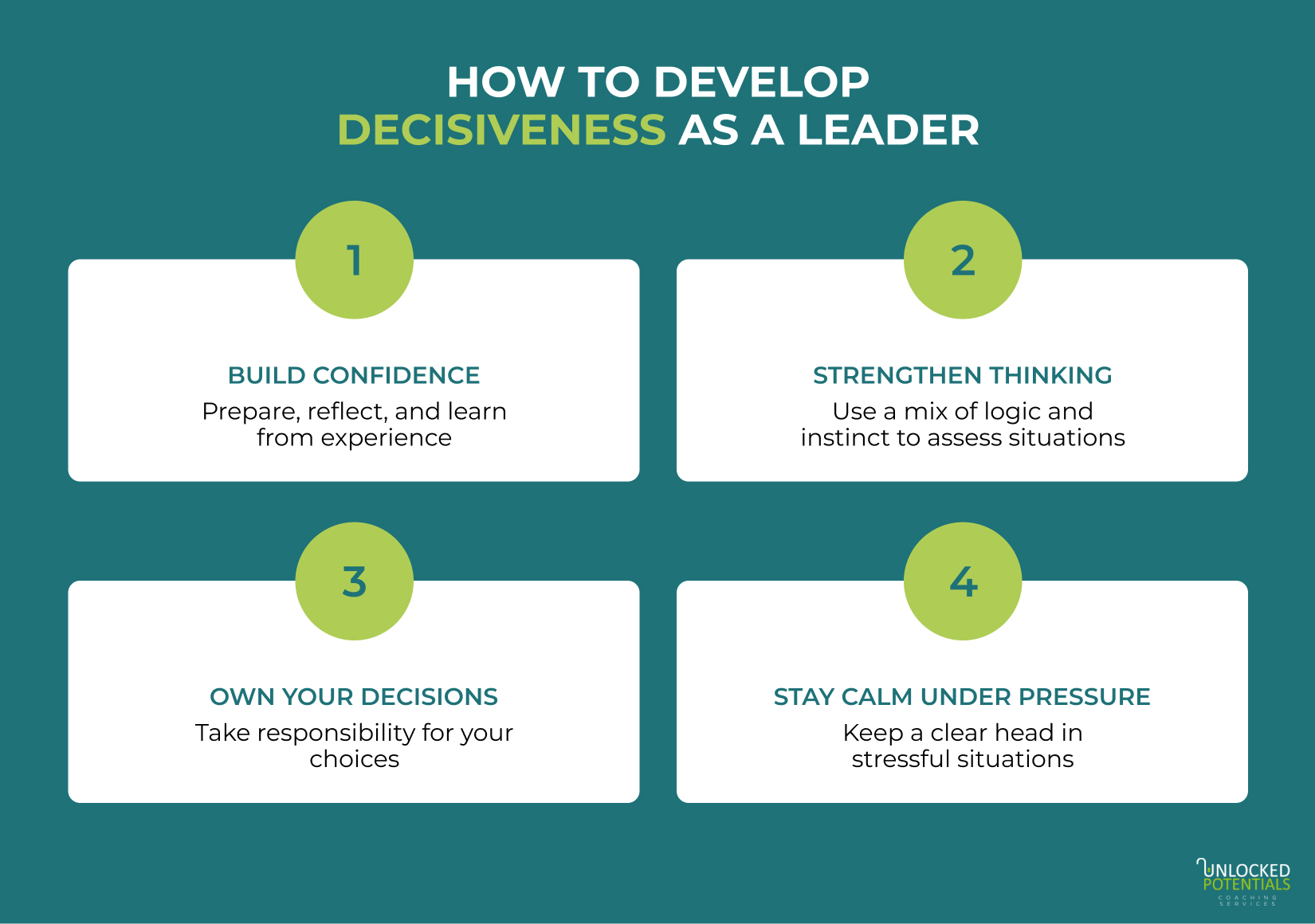10 Reasons Why Decisiveness Is Fundamental in Effective Leadership

In a world where things change in the blink of an eye, being decisive has never been more important for leaders. Decisiveness means making clear decisions and standing by them, even when the path is uncertain.
Leaders who develop this skill earn respect and trust from their teams. They provide direction when things feel unclear and help their teams move forward with confidence.
Decisiveness is the foundation of effective leadership. It sets apart those who lead purposefully from those who simply react to challenges.
What Does It Mean to Be Decisive as a Leader?
To be decisive as a leader means having the ability to make clear and timely decisions, even when faced with uncertainty or pressure. It is about taking responsibility for your choices and guiding your team forward with confidence rather than hesitating or second-guessing.
Decisiveness in leadership is not about making rash decisions or always knowing the perfect answer. Instead, it’s about using your experience, knowledge, and intuition to assess a situation and take action when it matters most.
Leaders who are decisive create stability in times of change. They inspire trust because their teams know that, no matter how complex the situation, decisions will be made with care and conviction.
In the workplace, this skill becomes invaluable, especially when deadlines are tight, challenges arise, and everyone looks to their leader for direction. Decisive leaders don’t just wait for the ‘right’ moment—they make the moment right through action.
Here are some of the characteristics of a decisive leader:
- Confidence: A confident leader believes in their abilities and trusts their judgement, even when the path is unclear.
- Clarity: Clarity is what allows leaders to cut through the noise and see what truly matters.
- Commitment: Once a decision is made, a decisive leader stands by it.
- Composure: A decisive leader stays centered and composed under pressure, making clear decisions without letting stress or emotion take over.
Why Decisiveness Is Important in Leadership
1. Sets the Tone and Direction
Every decision you make as a leader sends a signal about priorities, values, and what the organisation stands for. Whether it’s approving a strategy, shifting a timeline, or saying no to a project, your choices shape the culture more than any vision statement ever will.
When you decide with clarity, your team aligns. People stop second-guessing and start focusing. They gain direction from your confidence. In the absence of clear leadership, people drift. But when you lead decisively, you create focus and forward energy.
2. Maintains Momentum, Especially in Uncertainty
Uncertainty can paralyse teams. People wait, hold back, and look up, hoping someone will step in and say what’s next. If you hesitate as a leader, everything slows. Momentum stalls, deadlines stretch, and doubt takes hold.
Being decisive means having the courage to move with what you do know. A clear, timely decision restarts progress. It shows your team that even when things aren’t perfect, you won’t let the organisation stand still.
3. Brings Stability and Confidence Under Pressure
When pressure is high, teams don’t just need direction, they need emotional steadiness. If you freeze or show panic, the people around you absorb that fear. But when you act calmly and with purpose, you stabilise the environment.
Even an imperfect decision can settle a team, because it gives shape to the chaos. Your willingness to lead under stress builds deep trust, not because you have all the answers, but because you’re brave enough to make a call when it matters most.
4. Fostering a Culture of Trust and Accountability
Decisiveness sets the tone for the entire organisation. When leaders make clear, confident decisions, it creates a sense of stability, allowing employees to focus on their work without second-guessing their direction.
It also fosters a culture of accountability, where team members take ownership of their responsibilities rather than waiting for someone else to make a move.
5. Driving Productivity and Efficiency
Indecision leads to delays, confusion, and wasted time. If a leader cannot commit to a course of action, teams are left in limbo, unsure of what to prioritise.
Decisive leaders keep projects moving, ensuring that deadlines are met and resources are used effectively. They understand that making a decision, even if it later requires adjustment, is far better than doing nothing at all.
6. Encouraging Innovation and Growth
Taking decisive action does not mean always playing it safe. The most successful businesses are led by people who are willing to take calculated risks and embrace new ideas.
Decisive leaders encourage innovation by making bold choices and standing by them. They create an environment where creativity is valued, and employees feel safe to contribute ideas, knowing that their leaders will support well-reasoned decisions.
7. Strengthening Resilience in Uncertain Times
Every organisation will face periods of uncertainty—whether due to economic shifts, industry disruptions, or internal challenges. In these moments, decisive leadership is critical.
A leader who takes action, adapts to change, and reassures their team helps maintain morale and stability. In contrast, hesitation or inconsistency can create fear and insecurity, making difficult situations worse.
Leaders who act with confidence, even in uncertain times, help their organisations remain resilient and focused on long-term success.
8. Minimising Opportunity Costs
As a leader, every time you delay a decision, there’s something you’re potentially giving up, even if it’s not immediately visible. In business, timing is often as important as strategy. A missed client, an unclaimed market gap, a delayed product, these are all opportunity costs.
When you’re decisive, you increase your organisation’s responsiveness. You move fast enough to capture what others hesitate on. The window doesn’t stay open forever, so decisive leaders are those who recognise, act, and lead ahead of the curve.
9. Clarifying Organisational Priorities
Indecisiveness often leads to organisational confusion. Teams start chasing too many things at once, unsure of what matters most. When you, as a leader, make a firm decision, whether that’s a shift in focus, a strategic pivot, or a clear “no”, you help everyone understand where to direct their attention and energy.
Decisiveness cuts through the noise. It creates alignment. Teams stop second-guessing and start delivering because the goal is clear.
10. Enabling Consistent and Confident Communication
Leaders who waffle or change direction frequently damage not just their message, but their credibility. Teams begin to doubt the vision. Clients and stakeholders start asking: Do they actually know where they’re going?
Decisive leaders communicate with purpose. Even when plans evolve, they speak with clarity and intention. This builds trust, reinforces alignment, and inspires follow-through across the board.
The Consequences of Indecisiveness
When leaders struggle to make decisions, the effects often go beyond delays. Indecisiveness can slow down progress and leave people uncertain about their work. Understanding these consequences helps leaders recognise the value of making timely choices.
Opportunity Cost
Every time a decision is delayed, there’s a chance that useful ideas or important actions are missed, and those moments can’t always be recovered.
In leadership, time matters. Waiting too long to act may mean missing out on a new client, a key hire, or a window of opportunity to solve a problem before it escalates. Over time, these missed chances can hold back a team or even an entire organisation. Being willing to decide, even without having every answer, often moves things forward more than waiting for the perfect moment.
Team Fatigue
When a leader avoids making decisions, the team is left without clear direction, which can lead to stress, frustration, and a loss of motivation.
People want to do well, but they need to know where they’re going and what’s expected. Without clear guidance, teams may spend time on the wrong tasks, second-guess their choices, or wait for answers that don’t come. This slows down progress and wears people out. Over time, team members may become disengaged or lose trust in leadership. Decisiveness helps protect energy, focus, and morale, especially when challenges arise.
Decisiveness vs Indecisiveness: Impact on Leadership Performance
Decisiveness in leadership means making timely, clear decisions with confidence. It provides team direction, fosters trust, and ensures that progress continues even in challenging situations. Decisive leaders take responsibility for their choices, act purposefully, and inspire their teams to do the same.
Examples of how decisiveness benefits leadership:
- Teams know their priorities and can focus on achieving goals.
- Employees trust their leader’s judgement and feel secure in their roles.
- Projects move forward efficiently without unnecessary delays.
Indecisiveness, on the other hand, creates hesitation and confusion. When leaders delay making decisions, progress slows down and can lead to missed opportunities. Teams become uncertain, morale drops, and productivity suffers when clear guidance is absent.
Common effects of indecisiveness in leadership:
- Uncertainty spreads, making employees feel unsure about their work.
- Important opportunities may be lost due to delayed action.
- Trust in leadership weakens when decisions are constantly postponed.
Developing a Decisive Attitude as a Leader
Step 1: Build Confidence Through Preparation and Experience
The first step to developing a decisive attitude is building confidence in your abilities. Confidence comes from preparation and experience—whether that means understanding your industry inside out, learning from past decisions, or seeking guidance from mentors. When you know you’ve done your homework, making decisions becomes less daunting.
- Example: A business owner who thoroughly researches market trends feels more equipped to make investment decisions, even in uncertain times.
Step 2: Strengthen Your Critical Thinking Skills
Another key aspect is improving your critical thinking skills. Decisive leaders don’t rely on gut feeling alone; they assess situations quickly, weigh options, and consider possible outcomes before taking action. This requires a balance of logic and intuition, both of which improve with practice.
- Example: An aspiring leader facing a tough staffing decision might list pros and cons, consult with colleagues, and trust their judgement to make a fair choice.Step 3: Take Responsibility for Your Decisions
- Taking responsibility is equally important. A decisive attitude means accepting that not every decision will be perfect, but standing by your choice and learning from the results is what builds respect and trust.
- Example: A corporate trainer who introduces a new training method takes ownership of its success or failure, learning from feedback and adjusting as needed.
Step 4: Stay Calm and Composed Under Pressure
Finally, staying calm under pressure is essential. Decisive leaders don’t let fear of failure cloud their judgment. They remain composed, even when time is short, and stakes are high, making thoughtful decisions that keep their teams moving forward.
- Example: A manager handling a last-minute project change stays focused, reassesses priorities, and confidently leads their team through the shift.
Developing a decisive attitude takes time, but with every decision made, you become stronger, more confident, and better equipped to lead. In the end, it’s about trusting yourself and being willing to take the leap, knowing that every step—whether successful or not—contributes to your growth as a leader.
Decision-Making Styles: One Size Doesn’t Fit All
Different situations call for different ways of making decisions. The best leaders know how to choose a style that suits the moment, the team, and the goal.
-
Autocratic
This style is when the leader makes the decision alone, without asking others for input.
It works best in urgent situations, where waiting could cause harm or result in a delay. In a crisis or when time is short, quick action is needed, and this approach can bring clarity and speed. However, if used too frequently, it may cause team members to feel left out or unheard, so it’s essential to use it with care and explain the reasoning behind the decision whenever possible.
-
Democratic
In this style, the leader invites the team to share their thoughts before making a decision.
It’s useful when there’s time to discuss options and when you want to build trust and encourage teamwork. Team members feel more involved and valued when their ideas are heard. While it may take longer, it often leads to better solutions and stronger team commitment.
-
Consultative
Here, the leader listens to advice and gathers opinions, but still makes the final decision themselves.
This style allows for team input while maintaining clear decision-making. It works well when the leader needs to make a thoughtful choice while also respecting the experiences and views of others. It’s a good balance between leading and listening.
-
Adaptive
Adaptive decision-making means changing your style based on the situation, the people involved, and the needs of the moment.
Sometimes you’ll need to act fast, other times you’ll need to involve the team, and often you’ll do a bit of both. Being adaptive means paying attention to what’s happening around you and choosing the approach that will work best.
Shaping Tomorrow’s Leaders Through Decisive Action
Decisive leadership shapes strong organisations by building trust and providing clear direction. When leaders make confident decisions, teams feel supported and motivated to do their best.
In a world of uncertainty, being decisive helps businesses adapt and grow, even in challenging times. Future leaders need to trust themselves and learn from every choice they make.
Encouraging decisiveness means giving them the chance to step up. Every decision a leader makes leaves an impact, inspiring others to believe in themselves and take action when it matters most.
Frequently Asked Questions
Why is decisiveness important for leaders in fast-growing businesses
In a fast-changing market like the UAE, where business opportunities emerge quickly, leaders who make timely decisions enable their teams to act with clarity and confidence, keeping projects on track and minimising delays.
How can I improve decision-making when leading a diverse team?
To lead a diverse team effectively, listen to different viewpoints and make decisions that are fair and clear, while explaining the reasons behind your choice to build trust and understanding.
What should I do if I’m afraid of making the wrong decision at work?
Fear of mistakes is common, but avoiding decisions can lead to even bigger problems. Focus on gathering enough information, thinking through options, and then taking action (even if it’s not perfect), it helps you move forward and learn.
How can decisiveness affect employee motivation and performance?
When leaders are confident in their choices, teams feel more secure, which enables them to work more effectively, take initiative, and remain engaged.
What decision-making style is best for business leaders in the UAE?
There’s no single best style; it depends on the situation. However, being adaptive, where you sometimes act quickly and other times involve the team, works well in the UAE’s mix of fast-paced industries and collaborative cultures.
- September 2025
- August 2025
- July 2025
- June 2025
- May 2025
- April 2025
- March 2025
- February 2025
- January 2025
- December 2024
- November 2024
- October 2024
- September 2024
- August 2024
- July 2024
- June 2024
- May 2024
- December 2023
- November 2023
- August 2023
- July 2023
- June 2023
- May 2023
- April 2023
- March 2023
- February 2023
- January 2023
- December 2022
- November 2022
- October 2022
- September 2022
- August 2022
- July 2022
- June 2022
- May 2022
- April 2022
- March 2022
- February 2022
- January 2022
- December 2021
- November 2021
- October 2021
- September 2021
- August 2021
- July 2021
- June 2021
- May 2021
- April 2021
- March 2020
- February 2020
- January 2020
- December 2019
- November 2019
- October 2019
- September 2019
- August 2019
- July 2019
- June 2019
- May 2019
- April 2019
- March 2019
- February 2019
- January 2019
- December 2018
- November 2018
- October 2018
- September 2018
- August 2018
- July 2015
- May 2014












